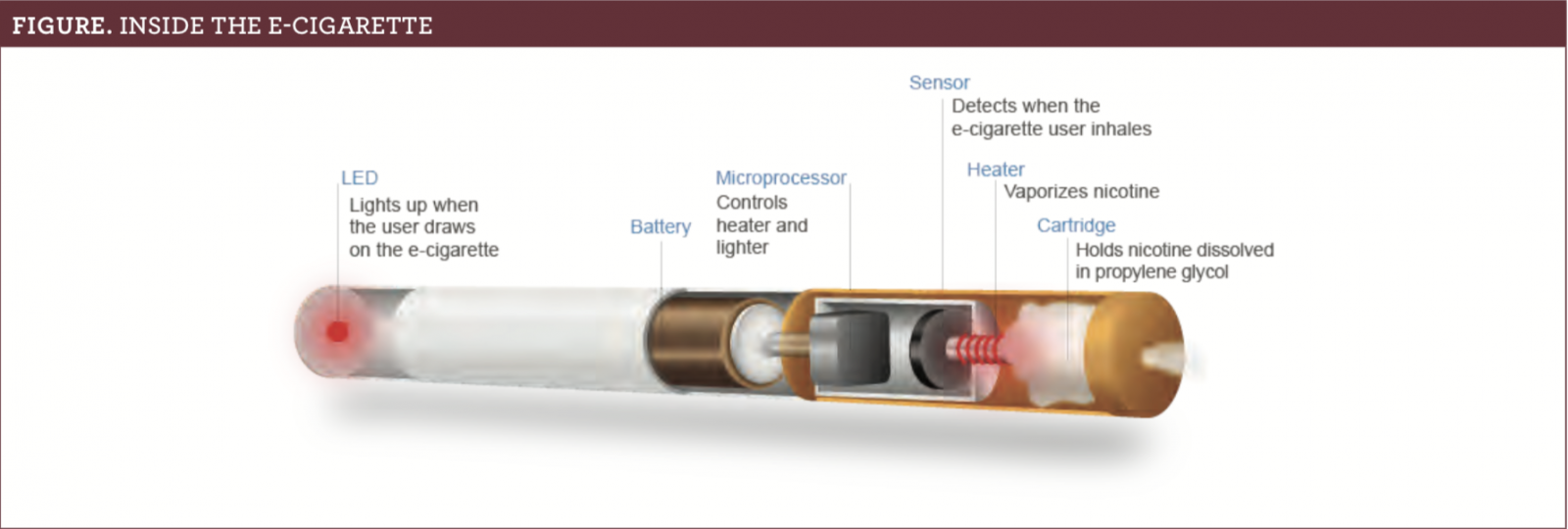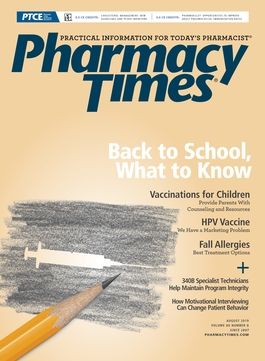Publication
Article
Pharmacy Times
Discuss Adverse Effects of Vaping With Patients
Author(s):
They may mistakenly believe that e-cigarettes are safe and wonder why they cause a cough.
E-cigarettes were introduced more than a decade ago, and their use in adults and youth has steadily increased since then. Some of the statistics related to e-cigarettes are sobering. Results of the FDA’s 2014 Population Assessment of Tobacco and Health study showed that more than 2 million adults use e-cigarettes daily and more than 3 million (prevalence, 2.4%) use them occasionally.1
Meanwhile, the surgeon general of the United States has described youth e-cigarette use as an “unprecedented epidemic.” Between 2011 and 2015, use of e-cigarettes grew 900% among high school students.2
Finally, 2018 National Youth Tobacco Survey results show astonishing increases in high school and middle school students’ use of e-cigarettes. From 2017 to 2018, e-cigarette use increased 78% among high school students and 48% among middle school students.3
Chances are, then, that a significant number of patients, especially within the teen group, are currently using, have previously used, or are exposed to e-cigarettes. Many will turn to health care professionals to answer questions about vaping. Counseling on smoking cessation, the harmful effects of both e-cigarette and conventional cigarette smoking, and dependable, trusted methods for quitting should all be a standard part of a pharmacist’s visit with these patients. Teaching patients about what is happening to their bodies when they are exposed to e-cigarettes not only gives them powerful knowledge about the risks of smoking but also encourages a trusting relationship between patient and provider.
One common question from patients: If e-cigarettes are not as unhealthy as regular cigarettes, why do they cause a cough?
Many e-cigarette users think that the aerosol they are inhaling is not harmful. But as more studies are released on the pathophysiological effects of e-cigarette vapor, experts are discovering that that belief is untrue. A typical e-cigarette cartridge contains benzene, diacetyl, heavy metals (lead, nickel, and tin), propylene glycol, and often flavorings.4 These components are responsible for cytotoxic, inflammatory responses in lung cells. Two of the products, diacetyl and propylene glycol, have been the focus of many recent studies, as these chemicals are found in much higher amounts in e-cigarettes than in conventional cigarettes.5-7
Propylene glycol, or glycerol, is a synthetic chemical used to maintain moisture.8 It is found in many skin care products, and as it exists in those products and in an e-cigarette cartridge, it is “generally recognized as safe” by the FDA.5 Unfortunately, that changes when the product is heated. As an e-cigarette user inhales on the device, and an atomizer heats the liquid in the cartridge, changing it to an aerosol that users can then inhale (see figure). When heated, propylene glycol chemically converts to formaldehyde, a known carcinogen, and the FDA’s “generally recognized as safe” designation no longer applies.2,5,6 Many studies have noted that the change in composition of e-cigarette liquid once it is heated produces a variety of toxic chemicals, including free radicals, particulates, nitrosamines, and volatile organic compounds.5-7 Further studies have found that exposure to e-cigarette vapor causes proinflammatory changes and increased activation of neutrophils. Neutrophil activation is a characteristic feature of chronic obstructive pulmonary disorder (COPD), raising concerns about long-term use of e-cigarettes and chronic disease.7 In the same vein as inflammatory complications, e-cigarette vapor has been found to inhibit phagocytosis (cellular ingestion of bacteria) in alveolar macrophages (AMs). Detection and phagocytosis of pathogens is a primary function of AMs. Typically, AMs initiate an immune response to infection in the airways. Therefore, any reduction in phagocytosis from e-cigarette vapor can potentially decrease the body’s innate immune response.6,7

Historically, inhalation of food flavorings has been associated with acute respiratory distress and/or respiratory failure.5-7 Diacetyl inhalation in a group of workers from a popcorn manufacturing plant is the most well-known case. The plant used diacetyl to flavor microwave popcorn until workers there started having breathing problems (dry cough, exhaustion, shortness of breath, and wheezing) after exposure to the airborne chemical. Those workers received a diagnosis of bronchiolitis obliterans, or popcorn lung.9 Bronchiolitis obliterans is a type of obstructive lung disease of the small airways. It is rare, with characteristic features of fibrosis in terminal and distal bronchioles and spirometry showing airflow obstruction. It usually leads to a progressive decline in lung function with no cure.7 Despite the widespread publicity surrounding popcorn lung, a recent study reported the presence of diacetyl in 70% of tested e-cigarettes.10
Armed with research about the effects of e-cigarette vapor on lung tissue, how do pharmacists then convey this to patients? One of the most important tactics is to dispel the myth that e-cigarettes are safe. Using some basic biology terms and descriptions can engage patients and show them that the pharmacist wants to share knowledge, building on the patient—provider relationship. These educational moments go a long way in treatment adherence and patient/provider satisfaction. Here are some comments to help get the conversation going:
- E-cigarettes have not been found to be less harmful than conventional cigarettes.
- E-cigarette vapor contains chemicals that can irritate and inflame lung tissue, which can cause coughing. The body is rejecting the chemicals, and coughing to expel them from the lungs is a natural reflex.
- Patients may be just as likely to develop serious lung conditions, such as COPD, using an e-cigarette versus a conventional cigarette.
- Lungs have cells, called macrophages, that act as a defense system against bacteria. E-cigarette vapor is toxic to these cells. Without them, people are much more likely to get sick because their lungs are weaker and unable to defend themselves.
Bethany Rettberg, NPC, is a family nurse practitioner at CVS MinuteClinic in Mokena, Illinois.
REFERENCES
- Rodu B, Plurphanswat N. E-cigarette use among US adults: Population Assessment of Tobacco and Health (PATH) study. Nicotine Tob Res. 2018;20(8):940-948. doi: 10.1093/ntr/ntx194.
- US Department of Health & Human Services. E-cigarette use among youth and young adults: a report of the surgeon general—executive summary. e-cigarettes. surgeongeneral.gov/documents/2016_SGR_Exec_Summ_508.pdf. Published 2016. Accessed July 1, 2019.
- Youth tobacco use: results from the National Youth Tobacco Survey. FDA website. www.fda.gov/TobaccoProducts/PublicHealthEducation/ProtectingKidsfromTobacco/ucm405173.htm. Updated May 29, 2019. Accessed July 1, 2019.
- About electronic cigarettes (e-cigarettes). CDC website. cdc.gov/tobacco/basic_ information/e-cigarettes/about-e-cigarettes.html. Updated November 15, 2018. Accessed March 25, 2019.
- Chun LF, Moazed F, Calfee CS, Matthay MA, Gotts JE. Pulmonary toxicity of e-cigarettes. Am J Physiol Lung Cell Mol Physiol. 2017;313(2):L193-L206. doi: 10.1152/ajplung.00071.2017.
- Scott A, Lugg ST, Aldridge K, et al. Pro-inflammatory effects of e-cigarette vapour condensate on human alveolar macrophages. Thorax. 2018;73(12):1161-1169. doi: 10.1136/thoraxjnl-2018-211663.
- Higham A, Rattray NJ, Dewhurst JA, et al. Electronic cigarette exposure triggers neutrophil inflammatory responses. Respir Res. 2016;17(1):56. doi: 10.1186/s12931-016-0368x. 8. Humectant. Merriam-Webster website. merriam-webster.com/dictionary/humectant. Accessed March 25, 2019.
- McArthur S. Vaping: the good, the bad and the popcorn lung. MPH Online website. mphonline.org/vaping-public-health. Accessed July 2, 2019.
- Farsalinos KE, Kistler KA, Gillman G, Voudris V. Evaluation of electronic cigarette liquids and aerosol for the presence of selected inhalation toxins. Nicotine Tob Res. 2015;17(2):168-174. doi: 10.1093/ntr/ntu176.







